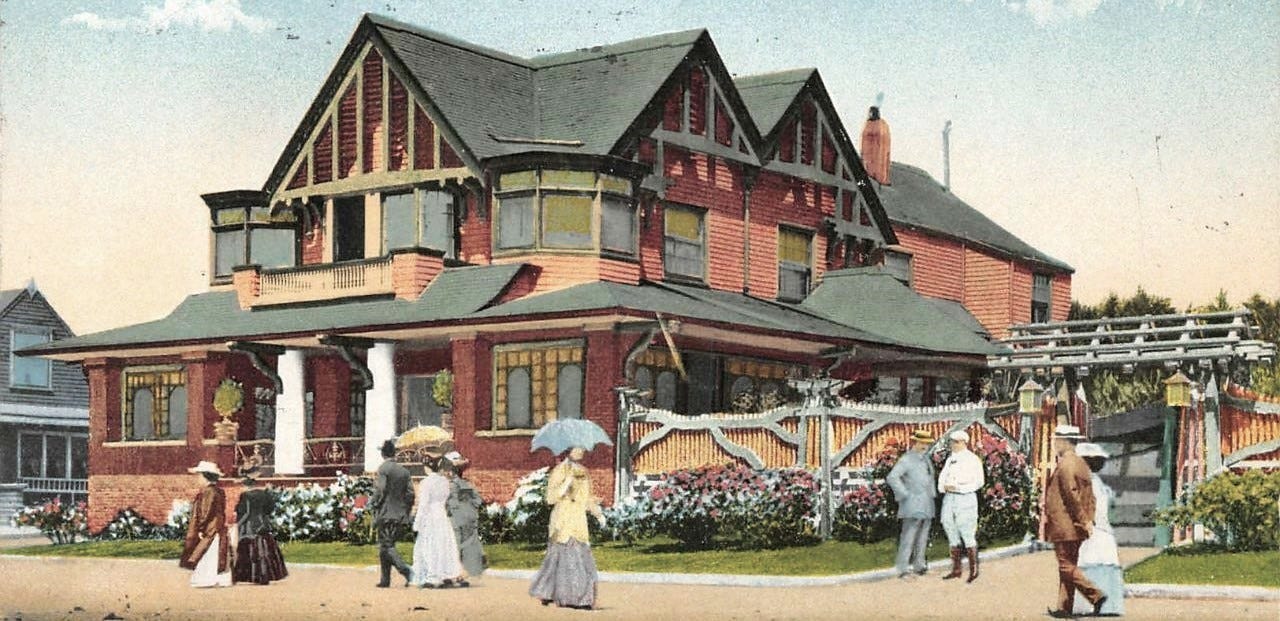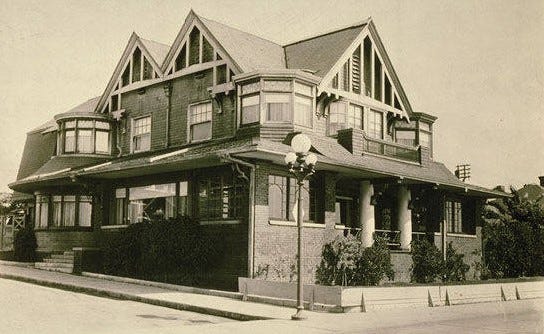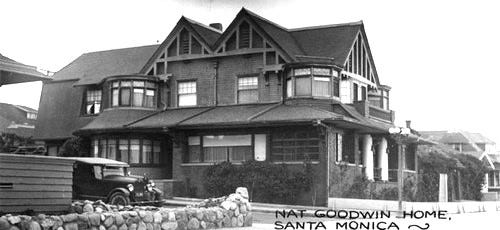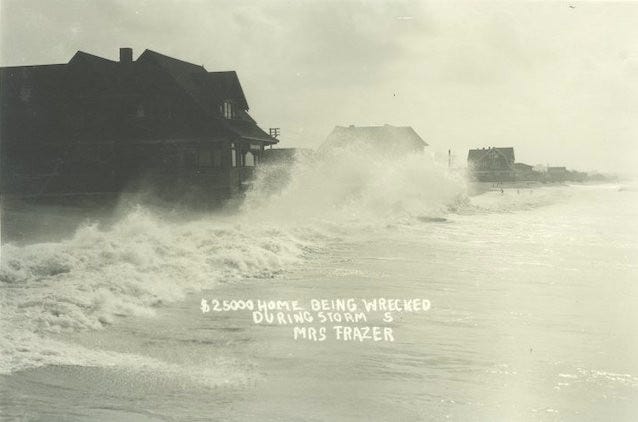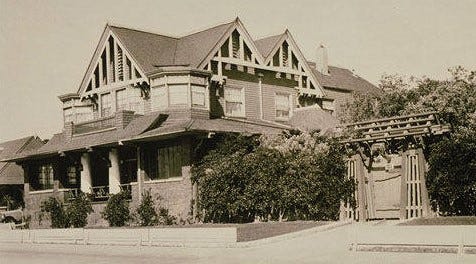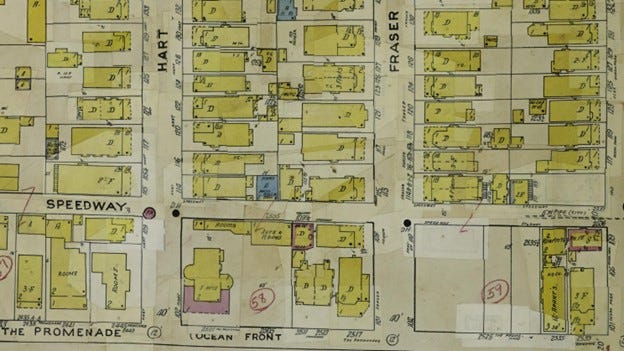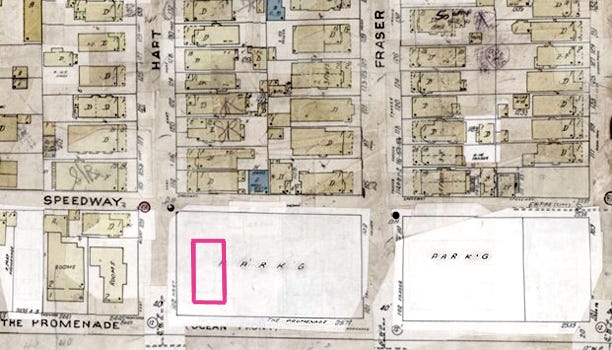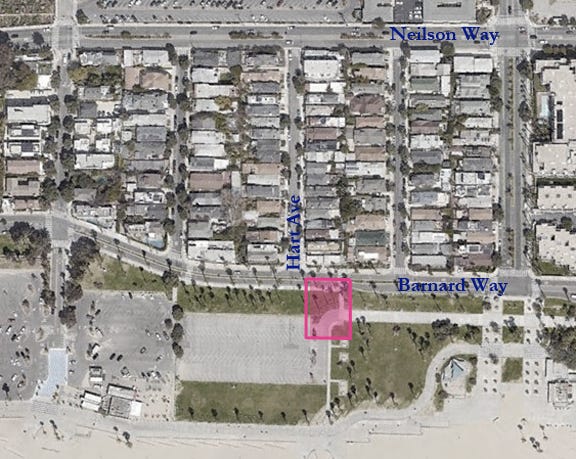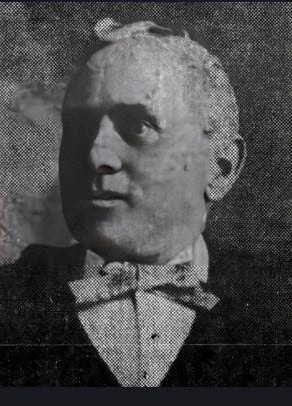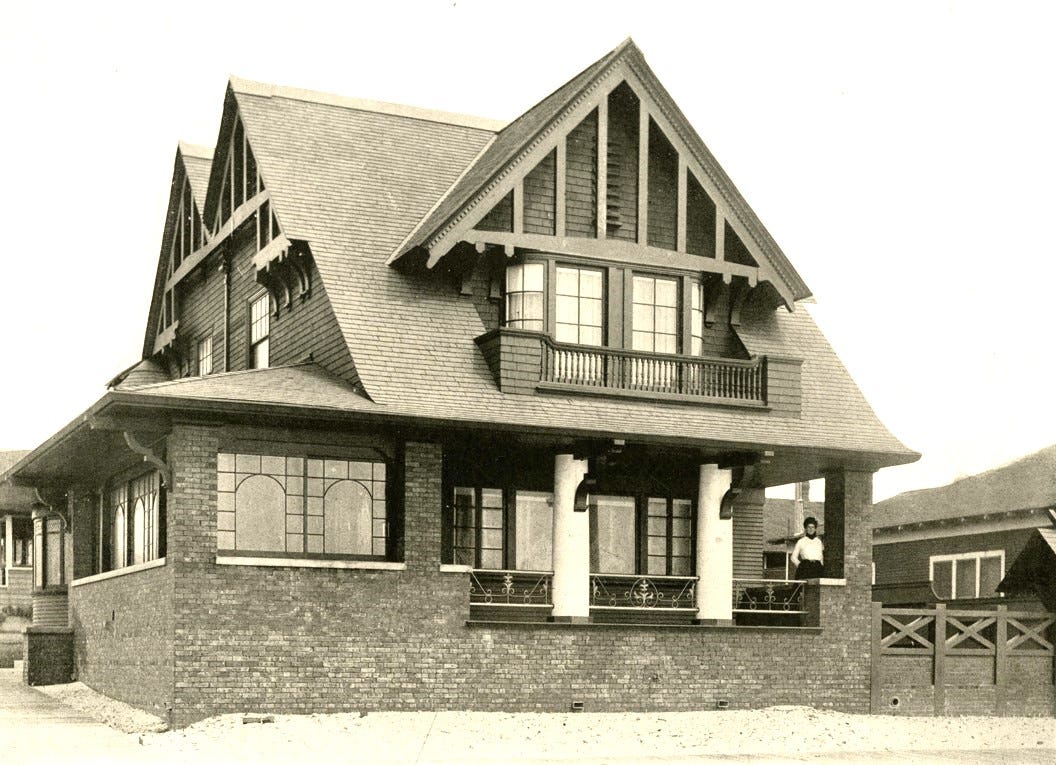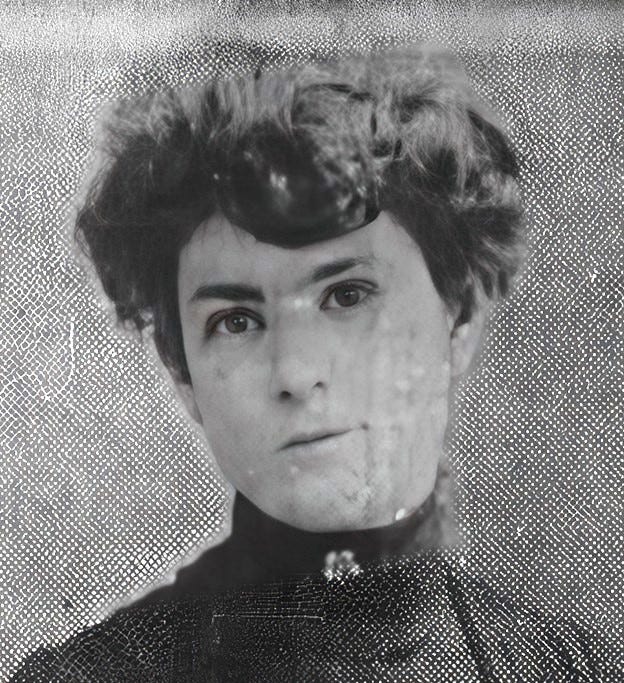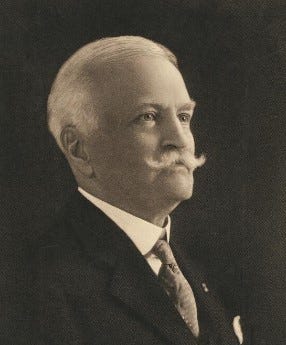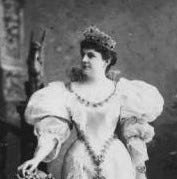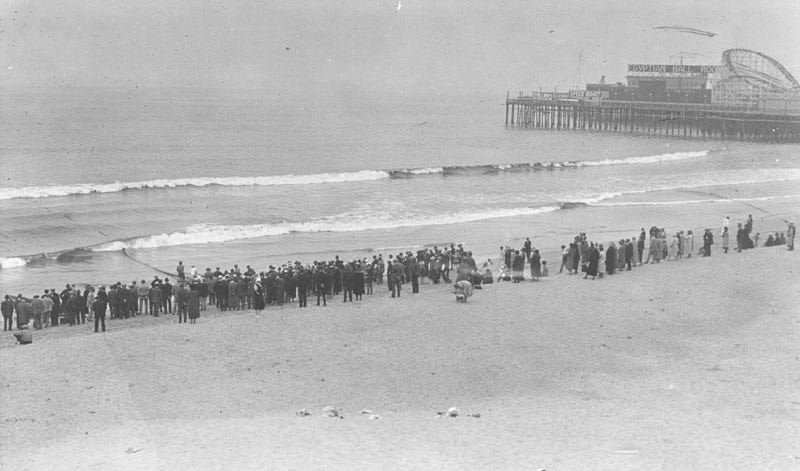For 60 years, from 1903, there is a grand 2-story house on the beach at the bottom of Hart Ave. Its most well known owner is Nathaniel Carl “Nat” Goodwin (1857 – 1919).
Thomas Fitzgerald (1850 – 1905)1 is what the newspapers call a “sporting man” – he makes his money running illegal betting parlors and operating horse racing tracks. In 1903, the Los Angeles police start cracking down on his operations. Fitzgerald retires to a 10-room, 2-story $10,000 house he builds2 on the SEC of Hart Ave and Ocean Front Walk. In 1903, as well as being a resort, Ocean Park is becoming popular amongst prominent Los Angeles businessmen (J.M. Davies (1830 – 1904), Frank Wiggins (1849-1924), W.T. Gibbon, and others) as a permanent home location.
Fitzgerald’s luck runs out in 1905. He becomes ill when his business partner Frederick Daniel Black (18?? – 1905) dies (in China) in June. Then his live-in housekeeper, 27-year-old Kitty Bell3 dies July 21 in a botched surgery. Two days later, on July 23, 1905, Fitzgerald dies.
After the close of his theatre season, Nat Goodwin, who is hanging out in Los Angeles and Ocean Park for several months in 1906, makes several investments and buys Fitzgerald’s house. Goodwin has his Chicago-era pal, Dorsey Patton, who is struggling financially, stay in the house and look after it. Patton dies in Goodwin’s house in December 1906.
At the end of 1906, Goodwin’s wife #3, Maxine Elliott, plans a big social event at the house, but rumors are spread about the house’s ‘haunted’ past. Maxine refuses to enter the house, and the event is canceled at the last minute. The much-married Goodwin is already in pursuit of wife #4, Edna Goodrich. In 1907 Goodwin announces that he is retiring from the stage, and becomes interested in Rawhide Nevada gold mines. In 1913 he opens the Nat Goodwin’s Café on the close by Bristol Pier (with his wife #5, Margaret Moreland running the kitchen). In 1916 Goodwin is in financial trouble - he sells the Goodwin Café to Baron Long (1883 – 1962), and the Ocean Park house to Charles Modini Wood (1855 - 1928),4 - and goes back to work on the stage - which kills him in 1919.
Charles Modini Wood is married to Mamie Perry (1862-1949),5 a Los Angeles opera diva and the daughter of Los Angeles lumber merchant and financial tycoon William Hayes Perry (1832 - 1906). When William Perry dies, Charles Wood becomes the president of the Central Properties Company which manages the Perry estate with several large downtown Los Angeles properties.
Grand diva Mamie Wood’s life centers on the opera and Los Angeles society. The Woods have several other houses (in downtown Los Angeles plus a large house in fashionable Lake Arrowhead where they spend the summer). In 1917, Wood applies for a building permit for “artist” additions to the Goodwin house, but runs into problems with the Santa Monica building department. In 1919, the alley behind (east) the house becomes Speedway6 for north-south beach traffic. By at least 1922, the Goodwin house is available for short-term lease. The most notorious leasee is evangelist Aimee Semple McPherson (1890 - 1944)7 in 1927. Recently returned from her kidnapping hoax, she separates from her mother and takes up a brief residence with her two children, Roberta Star Semple and Rolf McPherson, in the Goodwin house.
Charles Wood dies at his home in Los Feliz in 1928. In 1929, the Goodwin house (furnished, 15 rooms, 5 bedrooms, 3 car garage, servants quarters) is offered for sale at $75,000 (“a tremendous sacrifice”) or for rent.
Hollywood film processor, Joseph Aller (1882–1950)8 buys the Goodwin house9 and converts it into the 5-unit Goodwin Apartments.
The Goodwin Apartments are still owned by Juliet Aller in 1957.
In 1962, as preliminary work for Ocean Park Redevelopment Project, Ocean Ave (which dead-ends at Hollister) is connected to Speedway. Speedway is widened and all of the structures west of Speedway are demolished and replaced by City-owned parking lots.
Thomas Fitzgerald (1850 ? – 1905). Born in Little Falls, NY, Fitzgerald comes to Los Angeles in about 1885. He partners with Frederick Daniel Black (18?? – 1905) as Black, Fitzgerald & Co, to operate (illegal) betting parlors in Los Angeles and Vernon. He is part owner of Los Angeles racing track - Ascot Park. A confirmed bachelor, Fitzgerald leaves an estate of more than $300,000 to his siblings in NY. With Black and Fitzgerald dead, Josiah “Cy” Myrick, Jr. (1860 - 1934) inherits the Black, Fitzgerald & Co business.
The house is designed by Norman Foote Marsh (1871-1955) of Marsh & Russell architects.
Katherine (Kitty) L. Bell (1878 - 1905). A café waitress before becoming Fitzgerald’s live-in housekeeper for 6 months. She dies of septic peritonitis in a series of botched operations, and leaves an estate of $600. Her relatives try to extort the Fitzgerald estate by claiming that she is his common-law wife.
Charles Modini Wood (1855 1928). Born Charles Wood, in Illinois, he graduates from the University of Michigan in 1875, and moves to Italy in 1880 to train as a professional opera singer. He acquires the stage name Carlo Modini and makes his professional singing debut in Milan in 1882. In 1884, he tours Australia with Nellie Melba. In 1888 he returns to Illinois, then in 1889 moves to Los Angeles, where he is a singer and music teacher. In 1890, he marries Mary “Mamie” Perry Davis (1862-1949), an opera singer and daughter of Los Angeles tycoon William Hayes Perry (1832 - 1906).
Mary “Mamie” Perry Davis Wood (1862 - 1949). A Los Angeles classical singer trained in Italy. As the city's first operatic diva, she is credited with bringing enthusiasm for grand opera to the city. Daughter of Los Angeles tycoon William Hayes Perry (1832 - 1906), a lumber merchant, financier, theater owner, and director-president of the Los Angeles City Water Company. She marries Charles W. Davis (1859 – 1885) in 1883, and then Charles Modini Wood in 1890.
The 20ft wide city alley is established in 1900 with Fraser & Hart’s Central Beach tract. In 1919, it is officially renamed Speedway and is the only north-south traffic route along the beach (Neilson is an electric trolly right-of-way). In 1962, it is widened to 60 ft, and in 1966 renamed Barnard Way.
Aimee Semple McPherson (1890–1944) disappears from the beach in Venice (south of the Ocean Piers and near Rose Ave) in 1926. This is part of an elaborate hoax carried out to conceal a tryst and precipitates a media frenzy.
Joseph "Joe" Altschuler \ Aller (1882–1950). Joseph Altschuler is born in Moscow, Russia, and emigrates to the US in 1891. He is a photographer in New York City and marries Juliet Goldberg (1886 – 1975) in 1908. In 1916, Aller’s Laboratory Hollywood (Joseph Altschuler proprietor), develops film for D. W. Griffith (1875 - 1948). Aller’s brother, Simeon Aller, sells raw film to the Hollywood studios for Dupont. In 1921 Joseph Aller partners with Waterson Rothacker (1885 – 1960) to form Rothacker Aller Film Lab, one of the most prestigious film processing companies in Hollywood. In 1924 Rothacker Aller is acquired by Consolidated Film Industries.
We were unable to determine when Aller buys the house. He owns it in 1937, and it seems reasonable to assume that he bought it from the Charles Wood estate in about 1930.



